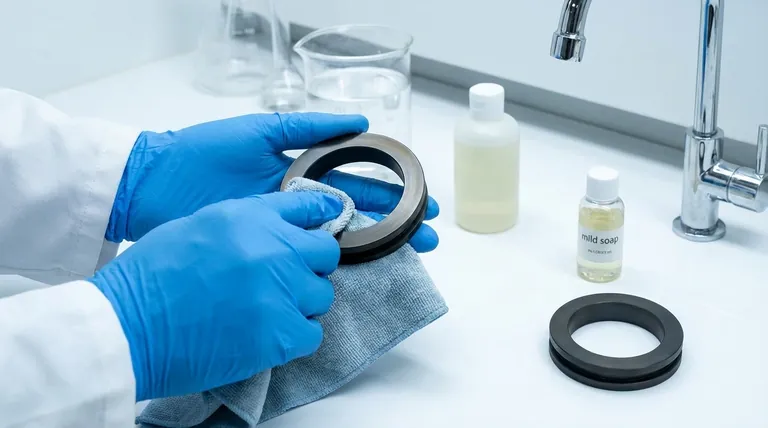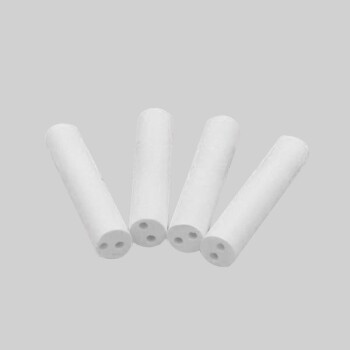To clean a finished PVD-coated surface, you should use only mild soap, water, and a soft microfiber cloth. The goal is to gently remove dirt and fingerprints without using any abrasive materials or harsh chemicals that could damage the thin protective layer. For more stubborn deposits like hard water stains, a solution of 50% water and 50% white vinegar can be effective, followed by a thorough rinse with clean water.
The core principle for cleaning any PVD-coated item is to protect its microscopic, high-performance surface layer. PVD coatings are exceptionally durable for their thickness, but they are not indestructible; aggressive cleaning methods will permanently damage them.

The Guiding Principle: Protecting the Thin Film
To properly care for a PVD surface, you must first understand what it is. The cleaning method is dictated entirely by the nature of the coating itself.
What is a PVD Coating?
PVD (Physical Vapor Deposition) is a process that bonds a microscopically thin layer of metal or ceramic material onto a base material, known as the substrate.
This process happens in a vacuum and creates a very strong bond. The resulting finish is significantly harder and more corrosion-resistant than the underlying material.
Why Aggressive Cleaning is Damaging
Though extremely tough, a PVD coating is typically only a few microns thick. For perspective, a human hair is about 70 microns thick.
Abrasive cleaners, scouring pads, or stiff brushes will physically wear away this thin layer, exposing the softer substrate underneath. Harsh chemicals can cause discoloration or etching, permanently altering the finish.
How to Clean Finished PVD Surfaces (Post-Coating Care)
This is the standard procedure for maintaining consumer and architectural products like faucets, watches, tools, or hardware.
For Routine Cleaning (Dust, Fingerprints)
A soft, clean microfiber cloth is your most important tool. It can be used dry for light dust or dampened with a simple solution of mild dish soap and warm water for fingerprints and grime.
After washing, always rinse the surface with clean water and dry it with a separate clean microfiber cloth to prevent water spots.
For Stubborn Stains (Hard Water, Grime)
For mineral deposits from hard water or more persistent grime, a 50/50 solution of white vinegar and water is a safe and effective choice.
Apply the solution with a soft cloth, let it sit for a minute, then gently wipe. It is critical to rinse the surface thoroughly with plain water afterward to neutralize the acid and then dry it completely.
What to Strictly Avoid
Never use any of the following on a PVD surface:
- Abrasive sponges, steel wool, or scouring pads.
- Cleaners containing chlorine, bleach, or ammonia.
- Scouring powders or abrasive creams.
- Strong acid or alkali-based cleaners.
Using these will almost certainly result in irreversible scratching, discoloration, or delamination of the coating.
A Critical Distinction: Cleaning Before PVD Deposition
It is essential to distinguish between cleaning a finished product and preparing a substrate for the PVD process itself. The latter is a highly technical, multi-stage industrial process where cleanliness is paramount.
Why Pre-Cleaning is Non-Negotiable
For a PVD coating to successfully bond, the substrate surface must be atomically clean. Any trace of oil, grease, oxidation, or microscopic particulate will prevent proper adhesion.
Poor adhesion leads to coating failure, such as peeling, flaking, or blistering. Therefore, rigorous cleaning before deposition is a critical manufacturing step.
A Typical Industrial Process
Preparing a substrate is far more involved than wiping it down. A typical sequence includes:
- Solvent Degreasing: To remove heavy oils and waxes.
- Ultrasonic Cleaning: Using specialized detergents in an ultrasonic bath to dislodge microscopic contaminants.
- Deionized Water Rinsing: Multiple rinses to remove all detergent residue.
- In-Situ Plasma Etching: A final cleaning step performed inside the PVD chamber right before coating begins, where ions bombard the surface to remove the final atomic layers of contamination.
Making the Right Choice for Your Goal
Your approach to cleaning depends entirely on whether you are maintaining a finished product or preparing a component for manufacturing.
- If your primary focus is everyday maintenance of a PVD product: Use only a microfiber cloth with mild soap and water, and avoid all abrasives and harsh chemicals.
- If your primary focus is preparing a substrate for PVD coating: A rigorous, multi-stage industrial cleaning process involving solvents, ultrasonics, and plasma etching is required to ensure proper adhesion.
Ultimately, proper care is the key to preserving the longevity and appearance of any PVD-coated surface.
Summary Table:
| Cleaning Scenario | Recommended Method | Key Tools/Materials | What to Avoid |
|---|---|---|---|
| Routine Cleaning (Dust, Fingerprints) | Mild dish soap & warm water | Soft microfiber cloth | Abrasive pads, harsh chemicals |
| Stubborn Stains (Hard Water, Grime) | 50/50 White Vinegar & Water solution | Soft cloth, thorough rinse | Bleach, ammonia, scouring powders |
| Industrial Pre-Cleaning (Before Coating) | Multi-stage process (solvents, ultrasonics, plasma) | Industrial equipment | Standard cleaning methods (insufficient for adhesion) |
Ensure the longevity and performance of your lab equipment with KINTEK's expertise. Proper surface preparation is critical for successful PVD coating adhesion and durability. Whether you are developing new coated components or maintaining existing ones, KINTEK's high-quality lab equipment and consumables are designed to meet rigorous standards.
Our team can help you select the right tools for surface preparation and cleaning protocols. Contact KINTEK today to discuss how we can support your laboratory's specific needs and enhance your research and development processes.
Visual Guide

Related Products
- Custom CVD Diamond Coating for Lab Applications
- RF PECVD System Radio Frequency Plasma-Enhanced Chemical Vapor Deposition RF PECVD
- Vacuum Hot Press Furnace Machine for Lamination and Heating
- CVD Diamond Cutting Tool Blanks for Precision Machining
- Customer Made Versatile CVD Tube Furnace Chemical Vapor Deposition Chamber System Equipment
People Also Ask
- What are diamond coated films? Enhance Materials with Super-Hard, Transparent Layers
- Is diamond coating worth it? Maximize Component Life and Performance
- Is diamond coating permanent? The Truth About Its Long-Lasting Durability
- How are tools coated with diamond? Achieve Superior Hardness and Low Friction for Your Tools
- What is the process of CVD diamond coating? Grow a Superior, Chemically-Bonded Diamond Layer



















